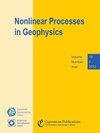通过同化古海平面资料到冰川均衡调整模式来约束地幔粘度的方法
IF 2.4
4区 地球科学
Q3 GEOSCIENCES, MULTIDISCIPLINARY
引用次数: 1
摘要
摘要冰川均衡调整在很大程度上受地幔流变特性的控制。海洋-冰冻圈系统中的大质量重新分布以及随后粘弹性地球的响应导致了过去海平面的剧烈变化。这一过程正在进行中,为了了解和预测当前和未来的海平面变化,粘度等地幔性质的知识至关重要。在这项研究中,我们提出了一种方法,通过将相对海平面变化率同化为岩石圈和地幔的粘弹性模型来获得地幔粘度的估计值。我们设置了一个具有概率重采样的粒子过滤器。在一个相同的孪晶实验中,我们表明,在一个由弹性岩石圈和两个不同粘度的地幔层组成的简单三层地球结构的冰川均衡调整模型中,可以恢复地幔层。我们研究了以下三个集合中不同参数的集合行为:(1)自上次冰川最大期以来的全球观测数据集,具有不同的集合初始化和观测不确定性,(2)仅从芬诺斯坎迪亚或劳伦蒂德/格陵兰进行的区域观测,以及(3)将观测周期限制在10 ka直到现在。我们证明,如果目标参数值由初始集合概率分布正确采样,则在所有情况下恢复都是成功的。这甚至包括目标粘度值位于初始整体概率分布尾部的情况。实验表明,如果有足够的近场观测,该方法是成功的。这种方法在大量冰川消融后的一段时间内效果最好,直到现在海平面指标的数量相对较高。本文章由计算机程序翻译,如有差异,请以英文原文为准。
An approach for constraining mantle viscosities through assimilation of palaeo sea level data into a glacial isostatic adjustment model
Abstract. Glacial isostatic adjustment is largely governed by the rheological
properties of the Earth's mantle. Large mass redistributions in the
ocean–cryosphere system and the subsequent response of the
viscoelastic Earth have led to dramatic sea level changes in the
past. This process is ongoing, and in order to understand and predict
current and future sea level changes, the knowledge of mantle
properties such as viscosity is essential. In this study, we present a
method to obtain estimates of mantle viscosities by the assimilation of
relative sea level rates of change into a viscoelastic model of the
lithosphere and mantle. We set up a particle filter with probabilistic
resampling. In an identical twin experiment, we show that mantle
viscosities can be recovered in a glacial isostatic adjustment model
of a simple three-layer Earth structure consisting of an elastic
lithosphere and two mantle layers of different viscosity. We
investigate the ensemble behaviour on different parameters in the following three set-ups: (1) global observations data set since last glacial maximum
with different ensemble initialisations and observation uncertainties,
(2) regional observations from Fennoscandia or Laurentide/Greenland
only, and (3) limiting the observation period to 10 ka until the
present. We show that the recovery is successful in all cases if the
target parameter values are properly sampled by the initial ensemble
probability distribution. This even includes cases in which the target
viscosity values are located far in the tail of the initial ensemble
probability distribution. Experiments show that the method is
successful if enough near-field observations are available. This makes
it work best for a period after substantial deglaciation until the present
when the number of sea level indicators is relatively high.
求助全文
通过发布文献求助,成功后即可免费获取论文全文。
去求助
来源期刊

Nonlinear Processes in Geophysics
地学-地球化学与地球物理
CiteScore
4.00
自引率
0.00%
发文量
21
审稿时长
6-12 weeks
期刊介绍:
Nonlinear Processes in Geophysics (NPG) is an international, inter-/trans-disciplinary, non-profit journal devoted to breaking the deadlocks often faced by standard approaches in Earth and space sciences. It therefore solicits disruptive and innovative concepts and methodologies, as well as original applications of these to address the ubiquitous complexity in geoscience systems, and in interacting social and biological systems. Such systems are nonlinear, with responses strongly non-proportional to perturbations, and show an associated extreme variability across scales.
 求助内容:
求助内容: 应助结果提醒方式:
应助结果提醒方式:


